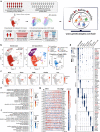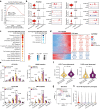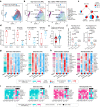Cellular hierarchy insights reveal leukemic stem-like cells and early death risk in acute promyelocytic leukemia
- PMID: 38365836
- PMCID: PMC10873341
- DOI: 10.1038/s41467-024-45737-7
Cellular hierarchy insights reveal leukemic stem-like cells and early death risk in acute promyelocytic leukemia
Abstract
Acute promyelocytic leukemia (APL) represents a paradigm for targeted differentiation therapy, with a minority of patients experiencing treatment failure and even early death. We here report a comprehensive single-cell analysis of 16 APL patients, uncovering cellular compositions and their impact on all-trans retinoic acid (ATRA) response in vivo and early death. We unveil a cellular differentiation hierarchy within APL blasts, rooted in leukemic stem-like cells. The oncogenic PML/RARα fusion protein exerts branch-specific regulation in the APL trajectory, including stem-like cells. APL cohort analysis establishes an association of leukemic stemness with elevated white blood cell counts and FLT3-ITD mutations. Furthermore, we construct an APL-specific stemness score, which proves effective in assessing early death risk. Finally, we show that ATRA induces differentiation of primitive blasts and patients with early death exhibit distinct stemness-associated transcriptional programs. Our work provides a thorough survey of APL cellular hierarchies, offering insights into cellular dynamics during targeted therapy.
© 2024. The Author(s).
Conflict of interest statement
The authors declare no competing interests.
Figures






Similar articles
-
PML/RARα-Regulated miR-181a/b Cluster Targets the Tumor Suppressor RASSF1A in Acute Promyelocytic Leukemia.Cancer Res. 2015 Aug 15;75(16):3411-24. doi: 10.1158/0008-5472.CAN-14-3521. Epub 2015 Jun 3. Cancer Res. 2015. PMID: 26041820 Free PMC article.
-
The clinically relevant CHK1 inhibitor MK-8776 induces the degradation of the oncogenic protein PML-RARα and overcomes ATRA resistance in acute promyelocytic leukemia cells.Biochem Pharmacol. 2023 Aug;214:115675. doi: 10.1016/j.bcp.2023.115675. Epub 2023 Jul 3. Biochem Pharmacol. 2023. PMID: 37406967
-
Activation of G0S2 is coordinated by recruitment of PML/RARα and C/EBPε to its promoter during ATRA-induced APL differentiation.J Leukoc Biol. 2017 Mar;101(3):655-664. doi: 10.1189/jlb.1A0316-116R. Epub 2016 Sep 7. J Leukoc Biol. 2017. PMID: 27605212
-
Understanding the molecular pathogenesis of acute promyelocytic leukemia.Best Pract Res Clin Haematol. 2014 Mar;27(1):3-9. doi: 10.1016/j.beha.2014.04.006. Epub 2014 Apr 13. Best Pract Res Clin Haematol. 2014. PMID: 24907012 Review.
-
The PML-RARalpha fusion protein and targeted therapy for acute promyelocytic leukemia.Leuk Lymphoma. 2004 Apr;45(4):639-48. doi: 10.1080/10428190310001609933. Leuk Lymphoma. 2004. PMID: 15160934 Review.
Cited by
-
Clinical characteristics and outcome of pediatric patients with high-risk acute promyelocytic leukemia, with special focus on risk factors of early death.Ann Hematol. 2025 Aug 12. doi: 10.1007/s00277-025-06528-2. Online ahead of print. Ann Hematol. 2025. PMID: 40794171
-
Molecular principles underlying aggressive cancers.Signal Transduct Target Ther. 2025 Feb 17;10(1):42. doi: 10.1038/s41392-025-02129-7. Signal Transduct Target Ther. 2025. PMID: 39956859 Free PMC article. Review.
-
Dual targeting of tumoral cells and immune microenvironment by blocking the IL-33/IL1RL1 pathway.Nat Commun. 2025 Jul 14;16(1):6369. doi: 10.1038/s41467-025-61567-7. Nat Commun. 2025. PMID: 40659660 Free PMC article.
-
Resolving Leukemia Heterogeneity and Lineage Aberrations with HematoMap.Genomics Proteomics Bioinformatics. 2025 May 30;23(2):qzaf005. doi: 10.1093/gpbjnl/qzaf005. Genomics Proteomics Bioinformatics. 2025. PMID: 39945785 Free PMC article.
-
Emerging clinical applications of single-cell RNA sequencing in oncology.Nat Rev Clin Oncol. 2025 May;22(5):315-326. doi: 10.1038/s41571-025-01003-3. Epub 2025 Feb 28. Nat Rev Clin Oncol. 2025. PMID: 40021788 Review.
References
MeSH terms
Substances
Grants and funding
LinkOut - more resources
Full Text Sources
Miscellaneous

